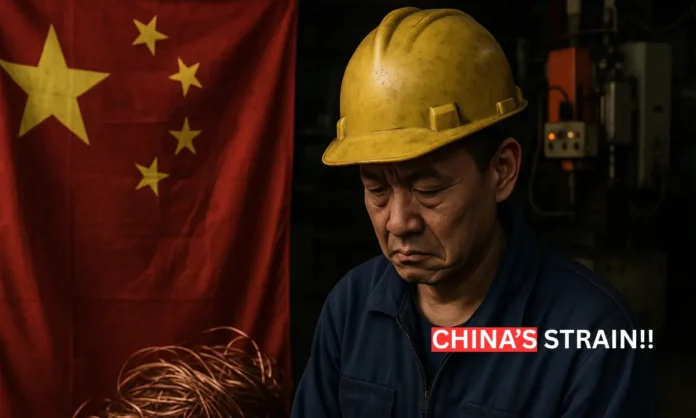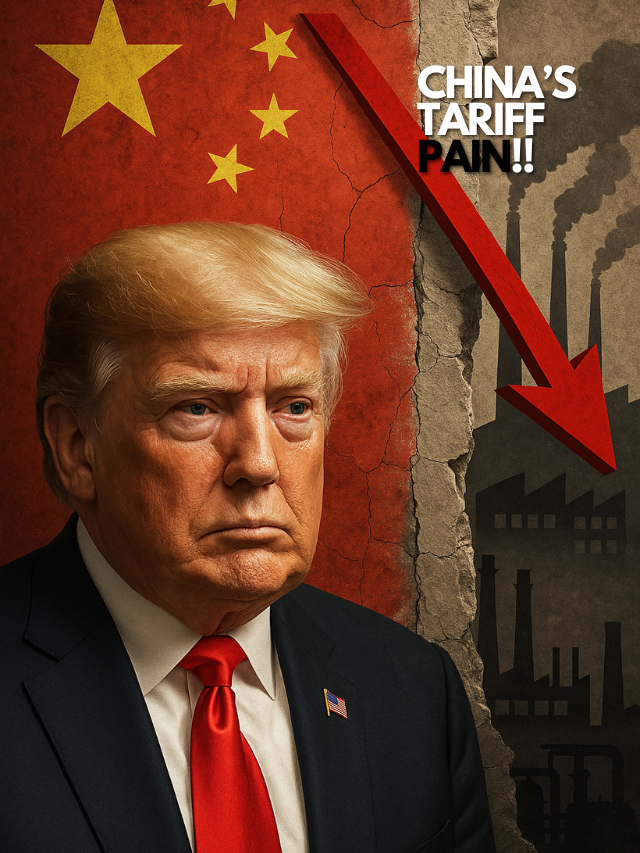SUMMARY
- China’s leaders are downplaying the crisis, but factory slowdowns and copper shortages reveal the real toll of Trump’s tariffs.
- Official data shows China’s manufacturing sector shrinking again, stoking fears of deeper recession risks.
- Behind the scenes, Beijing is quietly creating “whitelists” to exempt key US products from retaliatory tariffs.
Trade War Reality Check: China’s Economy Is Bleeding Behind a Brave Face
Despite an outward show of defiance, China’s economy is buckling under the weight of Trump’s aggressive tariff regime. The 145% tariffs imposed by the United States are gnawing into China’s already fragile post-pandemic recovery, exposing fault lines in manufacturing, exports, and critical commodity reserves.
Senior Chinese officials have scrambled to stabilize public sentiment by pledging support to industries and workers, but their confidence rings hollow against hard data: factory activity shrank in April, export optimism cratered, and inventories of vital commodities like copper are vanishing.
For the world’s second-largest economy, the Trump-era trade war—once dismissed as political theater—has become a tangible economic threat with potentially historic consequences.
President Trump, in a @WhiteHouse cabinet meeting, claimed his #tariffs are significantly impacting China's economy. The 145% tariffs have reportedly slowed China's growth, with GDP forecasts dropping to 4.5% for 2025, missing Beijing's 5% target.@AP pic.twitter.com/clWIwZMkP9
— Chloe Smith 🇺🇸 (@ChloeSmith1728) April 30, 2025
Factories Are Falling Silent: PMI Reveals Trade War Bite
- China’s manufacturing PMI plunged to 49 in April, below the critical 50-mark that separates growth from contraction.
- Even services PMI dropped to 50.4, reflecting weakening internal demand.
- Business sentiment, according to Caixin data, is at one of the lowest levels on record.
The April data sent an unmistakable signal: China’s factory floors are losing their buzz. The Purchasing Managers’ Index (PMI), a leading gauge of manufacturing health, fell sharply to 49 in April, compared to 50.5 in March. A score below 50 signals contraction, and this downturn is being pinned squarely on external demand shocks from the tariff war.
Private sector surveys painted an even grimmer picture. Caixin’s manufacturing index dipped to 50.4, showing that even China’s domestic consumption story cannot offset external headwinds. Economists like Zhiwei Zhang at Pinpoint Asset Management are blunt: “The weak manufacturing PMI in April is driven by the trade war.”
Worse still, logistics disruptions, weak orders, and employment declines were flagged, signaling that the slowdown is not limited to exports—it is system-wide.
The Copper Crisis: China’s Strategic Weakness Exposed
- China’s copper stockpiles are projected to run dry by mid-June amid surging US demand.
- Massive US copper imports ahead of tariff escalation are competing directly with China for global supplies.
- Beijing’s wafer-thin copper reserves mean energy and construction sectors could face crippling material shortages.
In an alarming development, China’s copper inventories—critical for industries like energy, construction, and EV manufacturing—are depleting at an unprecedented pace. According to Mercuria, a major commodity trader, China could face a total wipeout of copper stocks within weeks if current trends continue.
This shortage reflects a deeper vulnerability: while Beijing projects economic strength, its real inventory buffers are razor thin. A tightening copper market could amplify inflation risks, stunt industrial recovery, and force China into costly global bidding wars for key resources.
As Nicholas Snowdon of Mercuria warned, this is “potentially one of the greatest tightening shocks this market has ever seen.”
The Silent Concessions: Beijing’s Secret ‘Whitelist’ Strategy
- China is quietly compiling lists of US goods exempted from the 125% retaliatory tariffs.
- Pharmaceuticals, microchips, aircraft parts, and now ethane imports have been spared to avert domestic disruption.
- Companies are being privately notified to maintain the illusion of a “fight to the end” in public.
In a telling sign of how dire the situation is, Beijing has initiated secret “whitelists” of US products spared from tariffs. According to Reuters, Chinese authorities are quietly informing companies that certain critical imports—especially in healthcare, semiconductors, and energy—are exempt.
The approach reveals a dual strategy: maintain nationalistic bravado publicly while pragmatically averting economic disaster privately. Ethane imports, pharmaceutical technologies, and certain chip supplies are now excluded from tariff hikes—critical sectors where China simply cannot afford disruptions.
Yet, this stealthy backchannel policy underscores how severely Trump’s trade offensive has rattled Beijing’s leadership.
China’s Slippery Slope: Will Tariffs Tip It Into Prolonged Recession?
The cumulative impact of Trump’s tariffs is unmistakable: manufacturing shrinkage, commodity depletion, weakened business sentiment, and hidden concessions. While Chinese leaders continue to project strength, the cracks are widening—and fast.
Economists now predict China’s GDP growth could slip to 3.5% in 2025, well below its targets. Rate cuts, housing market stimulus, and export subsidies may slow the bleeding, but they are unlikely to reverse the underlying erosion in competitiveness.
Trump’s tariff playbook—once criticized as reckless—is increasingly looking like a sledgehammer reshaping the global economic order. And China, after decades of export-led dominance, appears to be struggling to adapt.
The question facing Beijing now isn’t whether it can weather the tariffs. It’s whether it can do so without sacrificing the credibility of its long-vaunted growth miracle.



